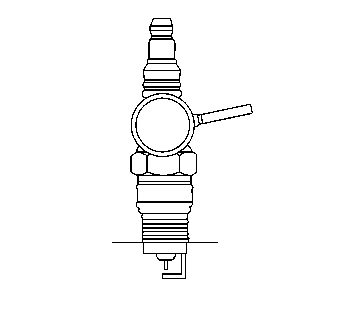Notice: These spark plugs have a ceramic insulator that is 3.175 mm (1/8 in) longer than earlier model spark plugs. Use a spark plug socket that is deep enough for these longer plugs (J 39358). Failure to do so could cause cracking of the insulator and arcing inside the plug resulting in an engine misfire.
Resistor type spark plugs with tapered seats are used. No gasket is needed on these plugs. These spark plugs are a High Efficiency (HE) spark plug that has a fine wire electrode, nickel plated shell and a platinum pad across from the electrode.

| • | Normal service is a mixture of idling, low speed, and high speed operation. |
| - | Occasional high speed driving is essential to good spark plug performance. |
| - | Increased combustion heat burns away excess carbon deposits, which accumulate from frequent idling or stop-and-go driving. |
| • | The heat resistant, insulating boot covers the spark plug terminal. |
| - | The boot extends over a portion of the spark plug insulator. |
| - | These boots prevent engine misfiring. |
| • | Corona discharge is a steady blue light appearing (in darkness) around the insulator, just above the shell crimp. |
| - | Do not mistake this for a shorted insulator. |
| - | This is visible evidence of a high-tension field. |
| - | This has no effect on ignition system performance. |
| - | This discharge repels dust particles. |
| - | This leaves a clear ring on the insulator just above the shell. |
| - | This is not evidence that combustion gases are escaping. |
Problem | Action | ||||||||||
|---|---|---|---|---|---|---|---|---|---|---|---|
Brown to Grayish-Tan Deposits and Slight Electrode Wear | |||||||||||
The spark plug has normal wear. | Clean, regap, and reinstall the spark plug. Refer to Spark Plug Replacement . | ||||||||||
Dry, Fluffy Black Carbon Deposits | |||||||||||
The spark plug has poor ignition output. | Inspect the spark plug wires and coil connections. | ||||||||||
Wet, Oily Deposits with Very Little Electrode Wear | |||||||||||
Break-in of a new or recently overhauled engine. | Degrease, clean, and reinstall the spark plugs. Refer to Spark Plug Replacement . | ||||||||||
The clearances of the valve stem guides are excessive. | Refer to Cylinder Head Clean and Inspect in Engine Mechanical - 4.3L. | ||||||||||
The intake valve seals are worn. | Replace the valve seals. Refer to Valve Stem Oil Seal and Valve Spring Replacement in Engine Mechanical - 4.3L. | ||||||||||
Colored Coatings on Insulator/Engine Misfires | |||||||||||
DEFINITION: The spark plug has red, brown, yellow, and white colored coatings on the insulator. The engine misfires intermittently under severe operating conditions. | |||||||||||
The coatings are the by-products of combustion. |
| ||||||||||
Heavy Colored Coating Deposits | |||||||||||
DEFINITION: Heavy colored coating deposits on the portion of the spark plug that projects into the chamber, and on the side facing the intake valve. | |||||||||||
The valve seals are leaking (if this condition is found in only one or two cylinders). |
| ||||||||||
Shiny Yellow Glaze Coating on Insulator | |||||||||||
The coating is caused from the melted by-products of combustion. |
| ||||||||||
Burned or Blistered Insulator Tips and Badly Eroded Electrodes | |||||||||||
The spark plugs are overheating. |
| ||||||||||
Broken or Cracked Insulator Tips | |||||||||||
The plugs show heat shock from a sudden rise in tip temperature under severe operating conditions. | Replace the spark plugs. Refer to Spark Plug Replacement . | ||||||||||
The spark plugs are improperly gapped. | Gap the plug to specification. Refer to Spark Plug Replacement . | ||||||||||
